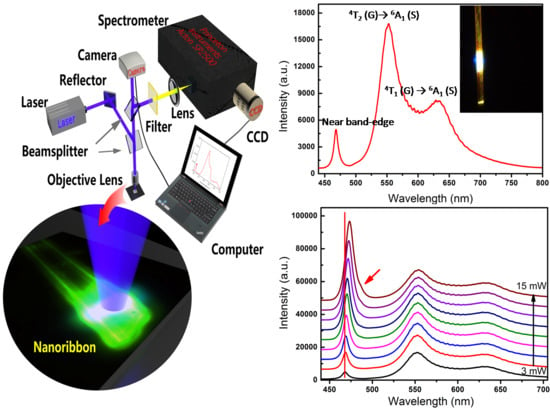Spin-Related Micro-Photoluminescence in Fe3+ Doped ZnSe Nanoribbons
Abstract
:1. Introduction
2. Experimental Section
3. Results and Discussion
4. Conclusions
Acknowledgments
Author Contributions
Conflicts of Interest
References
- Vukovic, N.; Healy, N.; Sparks, J.R.; Badding, J.V.; Horak, P.; Peacock, A.C. Tunable continuous wave emission via phase-matched second harmonic generation in a ZnSe microcylindrical resonator. Sci. Rep. 2015, 5, 11798. [Google Scholar] [CrossRef] [PubMed]
- Pawlis, A.; Panfilova, M.; As, D.; Lischka, K.; Sanaka, K.; Ladd, T.; Yamamoto, Y. Lasing of donor-bound excitons in ZnSe microdisks. Phys. Rev. B 2008, 77, 153304. [Google Scholar] [CrossRef]
- Hite, G.E.; Marple, D.T.F.; Aven, M.; Segall, B. Excitons and the absorption edge in ZnSe. Phys. Rev. 1967, 156, 850–859. [Google Scholar] [CrossRef]
- Ding, J.; Jeon, H.; Ishihara, T.; Hagerott, M.; Nurmikko, A.V.; Luo, H.; Samarth, N.; Furdyna, J. Excitonic gain and laser emission in ZnSe-based quantum wells. Phys. Rev. Lett. 1992, 69, 1707–1710. [Google Scholar] [CrossRef] [PubMed]
- Su, X.; Zheng, H. Influence of spin-phonon coupling on the spin-1/2 antiferromagnet on a square lattice. Solid State Commun. 1999, 109, 323–328. [Google Scholar] [CrossRef]
- Sangiovanni, G.; Gunnarsson, O.; Koch, E.; Castellani, C.; Capone, M. Electron-phonon interaction and antiferromagnetic correlations. Phys. Rev. Lett. 2006, 97, 046404. [Google Scholar] [CrossRef] [PubMed]
- Norris, D.J.; Yao, N.; Charnock, F.T.; Kennedy, T.A. High-quality manganese-doped ZnSe nanocrystals. Nano Lett. 2001, 1, 3–7. [Google Scholar] [CrossRef]
- Song, Y.; Sonntag, J.; Mirov, S.B.; Gmachl, C.F.; Khurgin, J.B. Mid-infrared light emission from a Fe2+: ZnSe polycrystal using quantum cascade laser pumping. Appl. Phys. Lett. 2014, 105, 141108. [Google Scholar] [CrossRef]
- Luo, M.; Giles, N.C.; Roy, U.N.; Cui, Y.; Burger, A. Energy transfer between Co2+ and Fe2+ ions in diffusion-doped ZnSe. J. Appl. Phys. 2005, 98, 083507. [Google Scholar] [CrossRef]
- Vlaskin, V.A.; Janssen, N.; van Rijssel, J.; Beaulac, R.M.; Gamelin, D.R. Tunable dual emission in doped semiconductor nanocrystals. Nano Lett. 2010, 10, 3670–3674. [Google Scholar] [CrossRef] [PubMed]
- Wang, C.; Xu, J.; Wang, Y.; Xu, S.; Qi, Z.; Lu, C.; Cui, Y. Manipulation of irradiative defects at MnSe and ZnSe dopant-host interface. Adv. Funct. Mater. 2016, 26, 4274–4282. [Google Scholar] [CrossRef]
- Kulyuk, L.L.; Laiho, R.; Lashkul, A.V.; Lähderanta, E.; Nedeoglo, D.D.; Nedeoglo, N.D.; Radevici, I.V.; Siminel, A.V.; Sirkeli, V.P.; Sushkevich, K.D. Magnetic and luminescent properties of iron-doped ZnSe crystals. Phys. B 2010, 405, 4330–4334. [Google Scholar] [CrossRef]
- Zhang, X.; Zhang, X.; Wang, L.; Wu, Y.; Wang, Y.; Gao, P.; Han, Y.; Jie, J. ZnSe nanowire/Si p-n heterojunctions: Device construction and optoelectronic applications. Nanotechnology 2013, 24, 395201. [Google Scholar] [CrossRef] [PubMed]
- Zhou, J.; Li, Y.; Wu, X.; Qin, W. Modulating the electronic and optical properties of tetragonal ZnSe monolayers by chalcogen dopants. ChemPhysChem 2016, 17, 1993–1998. [Google Scholar] [CrossRef] [PubMed]
- Binh, P.H.; Hung, N.T. High-speed visible light communications using ZnSe-based white light emitting diode. IEEE Photonics Technol. Lett. 2016, 28, 1948–1951. [Google Scholar] [CrossRef]
- Dietl, T. A ten-year perspective on dilute magnetic semiconductors and oxides. Nat. Mater. 2010, 9, 965–974. [Google Scholar] [CrossRef] [PubMed]
- Walsh, A.; Da Silva, J.; Wei, S.H. Theoretical description of carrier mediated magnetism in cobalt doped ZnO. Phys. Rev. Lett. 2008, 100, 256401. [Google Scholar] [CrossRef] [PubMed]
- Dietl, T.; Ohno, H. Dilute ferromagnetic semiconductors: Physics and spintronic structures. Rev. Mod. Phys. 2014, 86, 187–251. [Google Scholar] [CrossRef]
- Wu, M.W.; Jiang, J.H.; Weng, M.Q. Spin dynamics in semiconductors. Phys. Rep. 2010, 493, 61–236. [Google Scholar] [CrossRef]
- Kamran, M.A.; Liu, R.; Shi, L.J.; Li, Z.A.; Marzi, T.; Schoppner, C.; Farle, M.; Zou, B. Tunable emission properties by ferromagnetic coupling Mn(II) aggregates in Mn-doped CdS microbelts/nanowires. Nanotechnology 2014, 25, 385201. [Google Scholar] [CrossRef] [PubMed]
- Heitz, R.; Hoffmann, A.; Broser, I. Fe3+ center in ZnO. Phys. Rev. B 1992, 45, 8977–8988. [Google Scholar] [CrossRef]
- Furdyna, J.K. Diluted magnetic semiconductors. J. Appl. Phys. 1988, 64, R29–R64. [Google Scholar] [CrossRef]
- Begum, S.M.; Rao, M.C.; Aparna, Y.; Rao, P.S.; Ravikumar, R.V. Spectroscopic investigations of Fe3+ doped poly vinyl alcohol (PVA) capped ZnSe nanoparticles. Spectrochim. Acta Part A 2012, 98, 100–104. [Google Scholar] [CrossRef] [PubMed]
- Yadav, K.; Jaggi, N. Aging effect on the structural and optical properties of ZnSe nanostructures. J. Mater. Sci. Mater. Electron. 2015, 27, 393–398. [Google Scholar] [CrossRef]
- Anand, S.; Verma, P.; Jain, K.P.; Abbi, S.C. Temperature dependence of optical phonon lifetimes in ZnSe. Phys. B 1996, 226, 331–337. [Google Scholar] [CrossRef]
- Wang, F.; Zhang, Z.; Liu, R.; Wang, X.; Zhu, X.; Pan, A.; Zou, B. Structure and stimulated emission of ZnSe nanoribbons grown by thermal evaporation. Nanotechnology 2007, 18, 305705. [Google Scholar] [CrossRef]
- Xing, G.; Luo, J.; Li, H.; Wu, B.; Liu, X.; Huan, C.H.A.; Fan, H.J.; Sum, T.C. Ultrafast exciton dynamics and two-photon pumped lasing from ZnSe nanowires. Adv. Opt. Mater. 2013, 1, 319–326. [Google Scholar] [CrossRef]
- Ugeda, M.M.; Bradley, A.J.; Shi, S.F.; Felipe, H.; Zhang, Y.; Qiu, D.Y.; Ruan, W.; Mo, S.K.; Hussain, Z.; Shen, Z.X.; et al. Giant bandgap renormalization and excitonic effects in a monolayer transition metal dichalcogenide semiconductor. Nat. Mater. 2014, 13, 1091–1095. [Google Scholar] [CrossRef] [PubMed]
- Bagnall, D.M.; Chen, Y.F.; Zhu, Z.; Yao, T.; Shen, M.Y.; Goto, T. High temperature excitonic stimulated emission from ZnO epitaxial layers. Appl. Phys. Lett. 1998, 73, 1038–1040. [Google Scholar] [CrossRef]
- Zou, S.; Kamran, M.A.; Shi, L.J.; Liu, R.; Guo, S.; Kavokin, A.; Zou, B. Bosonic lasing from collective exciton magnetic polarons in diluted magnetic nanowires and nanobelts. ACS Photonics 2016, 3, 1809–1817. [Google Scholar] [CrossRef]
- Liu, R.; Shi, L.; Zou, B. The magnetic exciton relaxation and spin-spin interaction by the time-delayed photoluminescence spectra of ZnO: Mn nanowires. ACS Appl. Mater. Interfaces 2014, 6, 10353–10366. [Google Scholar] [CrossRef] [PubMed]
- Komarov, A.V.; Ryabchenko, S.M.; Terletseii, O.V. Giant spin splitting of exciton states in ZnSe with Mn and Fe impurities. Phys. Status Solidi b 1980, 102, 603–609. [Google Scholar] [CrossRef]
- Zu, P.; Tang, Z.K.; Wong, G.K.L.; Kawasaki, M.; Ohtomo, A.; Koinuma, H.; Segawa, Y. Ultraviolet spontaneous and stimulated emissions from ZnO microcrystallite thin films at room temperature. Solid State Commun. 1997, 103, 459–463. [Google Scholar] [CrossRef]
- Lu, X.F.; Wang, N.Z.; Wu, H.; Wu, Y.P.; Zhao, D.; Zeng, X.Z.; Luo, X.G.; Wu, T.; Bao, W.; Zhang, G.H.; et al. Coexistence of superconductivity and antiferromagnetism in (Li0.8Fe0.2)OHFeSe. Nat. Mater. 2015, 14, 325–329. [Google Scholar] [CrossRef] [PubMed]
- Zhang, X.T.; Liu, Z.; Leung, Y.P.; Li, Q.; Hark, S.K. Growth and luminescence of zinc-blende-structured ZnSe nanowires by metal-organic chemical vapor deposition. Appl. Phys. Lett. 2003, 83, 5533. [Google Scholar] [CrossRef]
- Zou, Y.; Li, H.; Ren, P.; Xu, J.; Ma, L.; Wang, X.; Fan, X.; Shan, Z.; Zhuang, X.; Zhou, H.; et al. Microphotoluminescence of individual ZnSe nanoribbons. Mater. Lett. 2014, 129, 118–121. [Google Scholar] [CrossRef]
- Philipose, U.; Xu, T.; Yang, S.; Sun, P.; Ruda, H.E.; Wang, Y.Q.; Kavanagh, K.L. Enhancement of band edge luminescence in ZnSe nanowires. J. Appl. Phys. 2006, 100, 084316. [Google Scholar] [CrossRef]
- Malikova, L.; Krystek, W.; Pollak, F.H.; Dai, N.; Cavus, A.; Tamargo, M.C. Temperature dependence of the direct gaps of ZnSe and Zn0.56Cd0.44Se. Phys. Rev. B 1996, 54, 1819–1824. [Google Scholar] [CrossRef]
- He, H.; Yang, Q.; Liu, C.; Sun, L.; Ye, Z. Size-dependent surface effects on the photoluminescence in ZnO nanorods. J. Phys. Chem. C 2010, 115, 58–64. [Google Scholar] [CrossRef]
- Yang, G.; Ma, Z.; Zhong, H.; Zou, S.; Chen, C.; Han, J.; Zou, B. Probing exciton move and localization in solution-grown colloidal CdSexS1–x alloyed nanowires by temperature- and time-resolved spectroscopy. J. Phys. Chem. C 2015, 119, 22709–22717. [Google Scholar] [CrossRef]
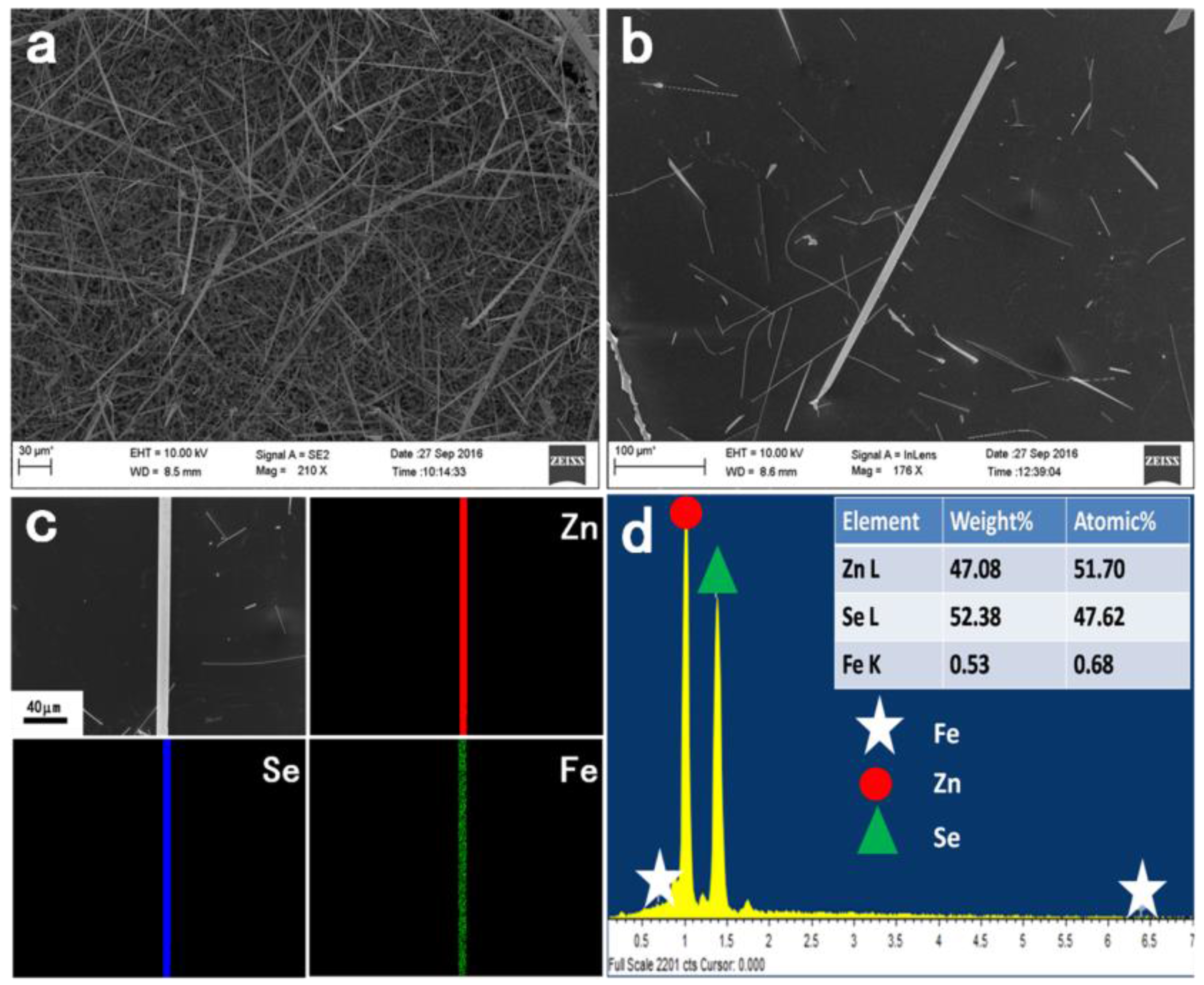
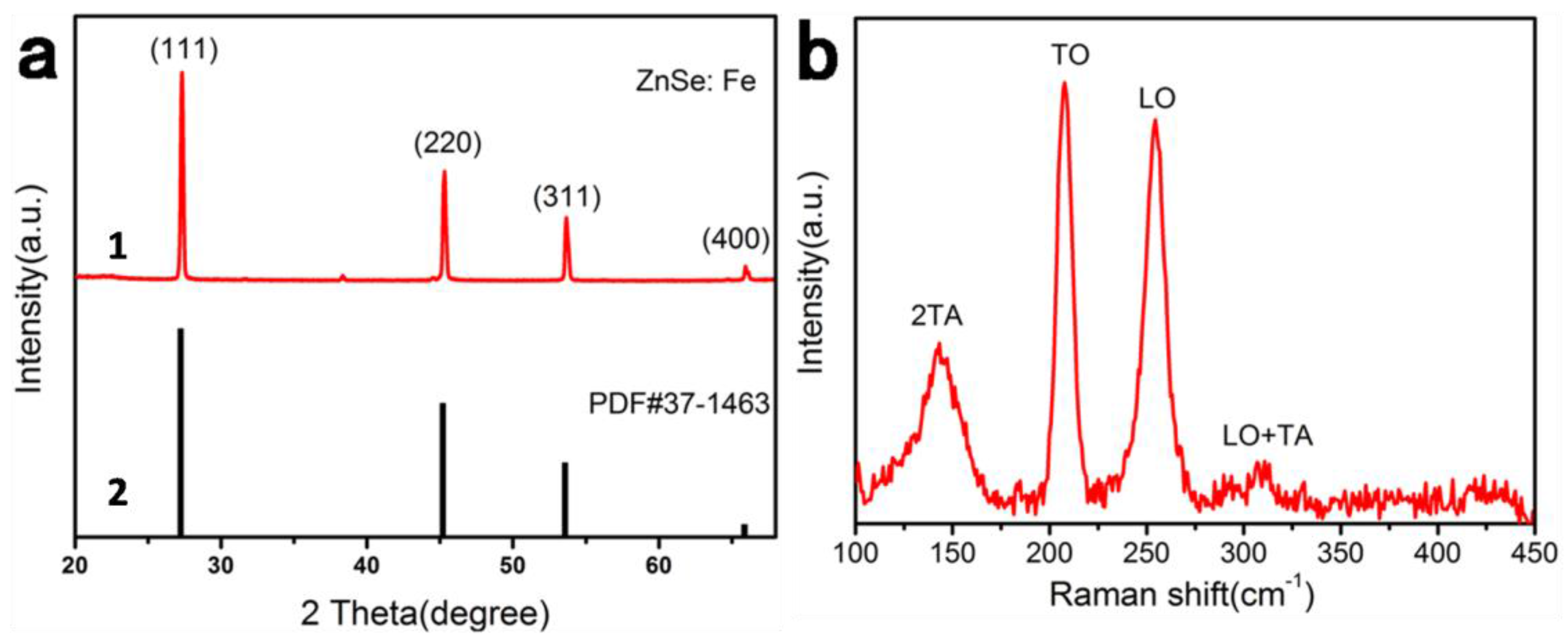
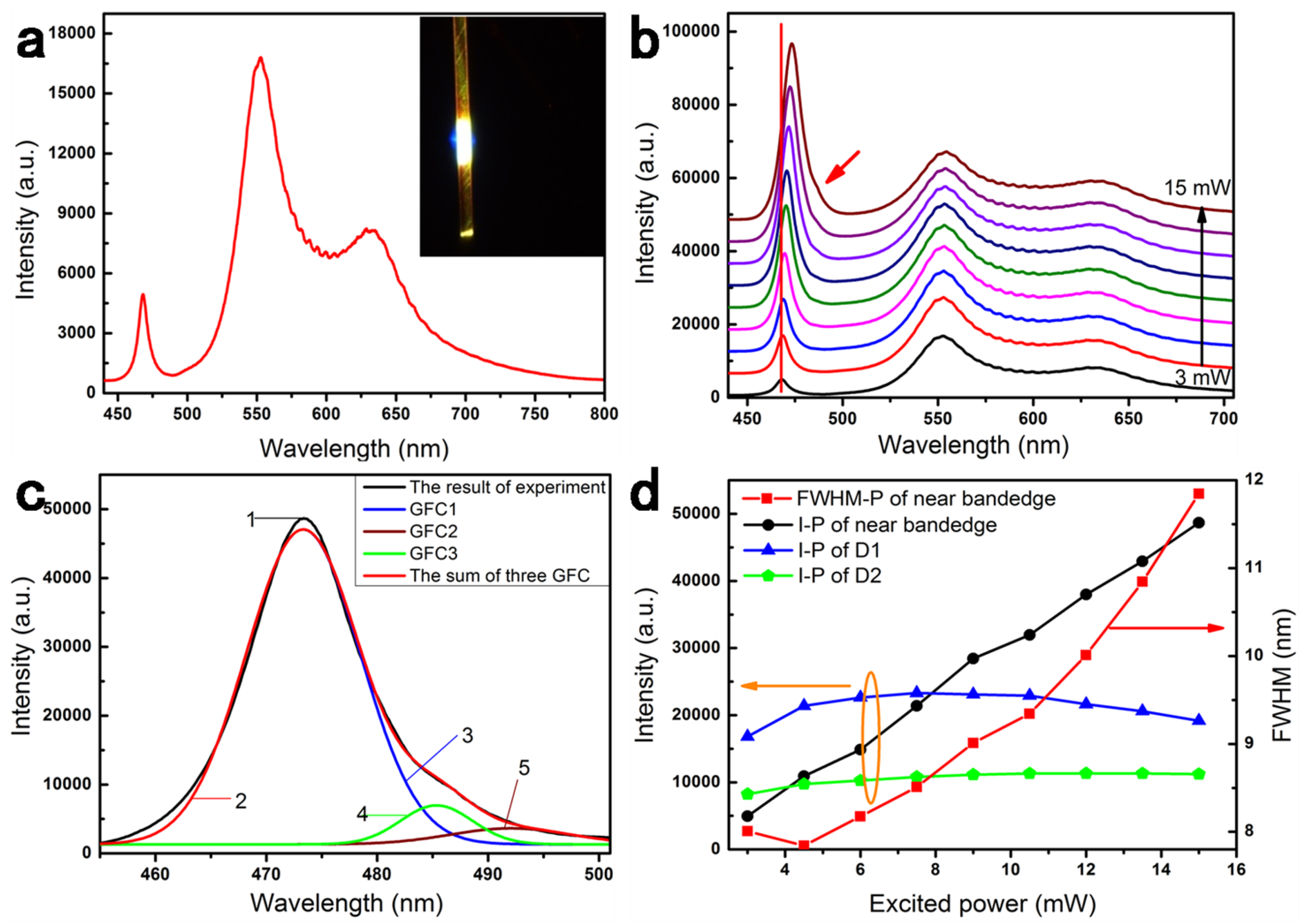
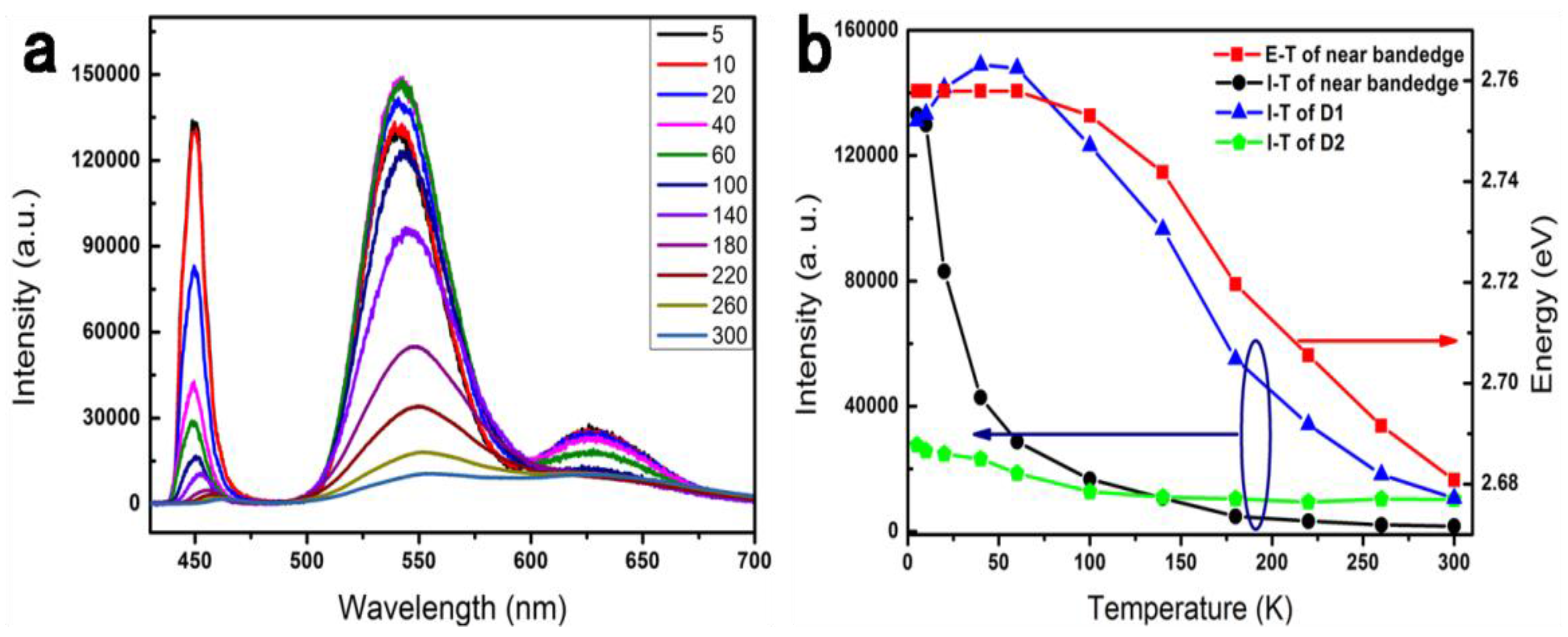
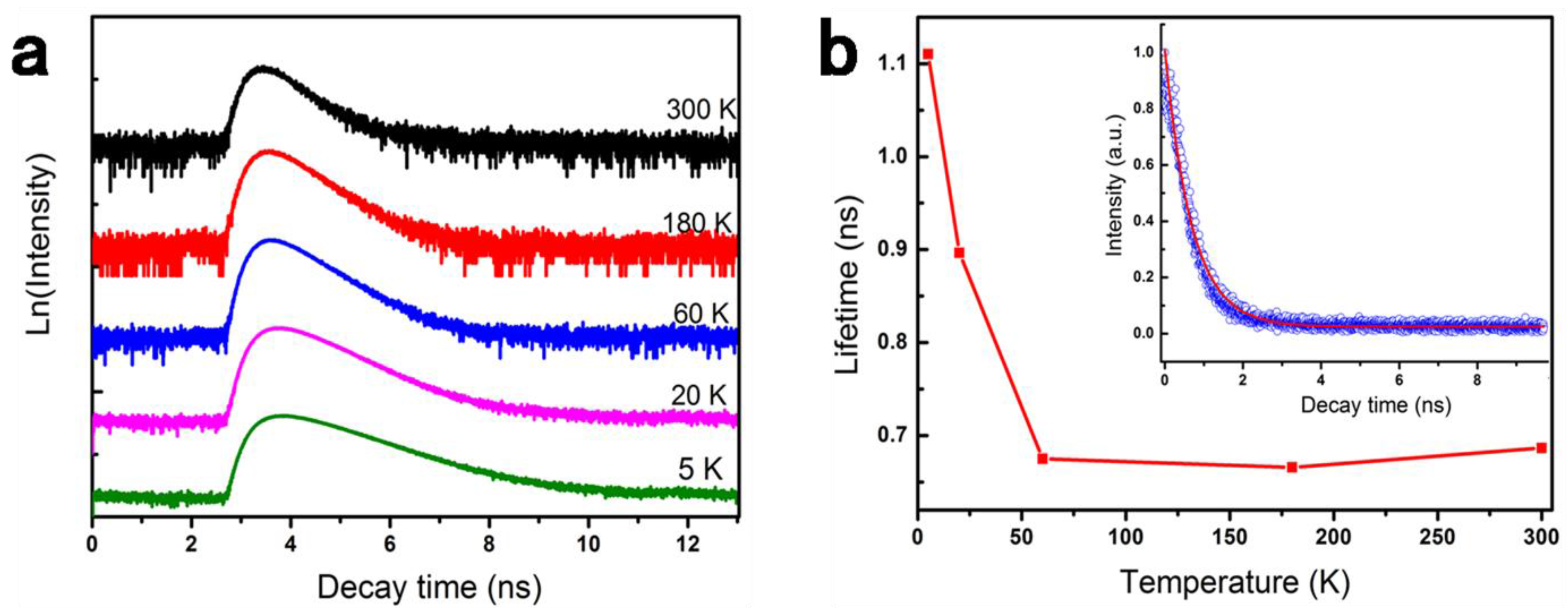
© 2016 by the authors; licensee MDPI, Basel, Switzerland. This article is an open access article distributed under the terms and conditions of the Creative Commons Attribution (CC-BY) license (http://creativecommons.org/licenses/by/4.0/).
Share and Cite
Hou, L.; Chen, C.; Zhang, L.; Xu, Q.; Yang, X.; Farooq, M.I.; Han, J.; Liu, R.; Zhang, Y.; Shi, L.; et al. Spin-Related Micro-Photoluminescence in Fe3+ Doped ZnSe Nanoribbons. Appl. Sci. 2017, 7, 39. https://doi.org/10.3390/app7010039
Hou L, Chen C, Zhang L, Xu Q, Yang X, Farooq MI, Han J, Liu R, Zhang Y, Shi L, et al. Spin-Related Micro-Photoluminescence in Fe3+ Doped ZnSe Nanoribbons. Applied Sciences. 2017; 7(1):39. https://doi.org/10.3390/app7010039
Chicago/Turabian StyleHou, Lipeng, Cheng Chen, Li Zhang, Qiankun Xu, Xinxin Yang, Muhammad Ismail Farooq, Junbo Han, Ruibin Liu, Yongyou Zhang, Lijie Shi, and et al. 2017. "Spin-Related Micro-Photoluminescence in Fe3+ Doped ZnSe Nanoribbons" Applied Sciences 7, no. 1: 39. https://doi.org/10.3390/app7010039





